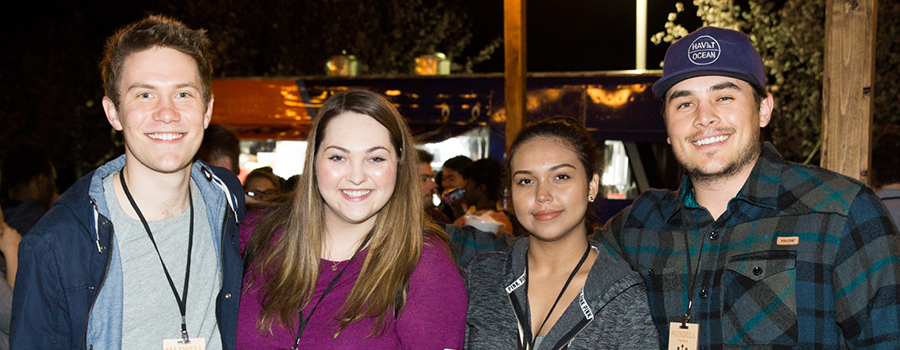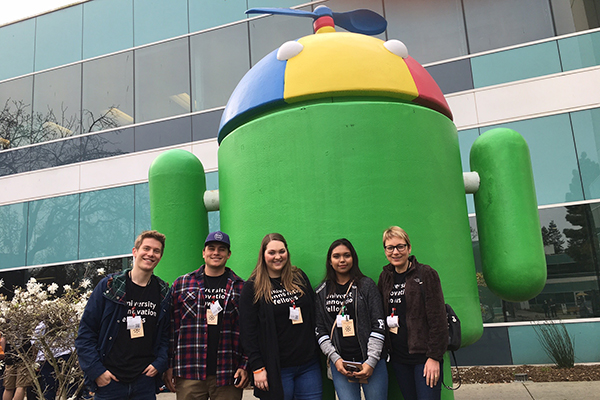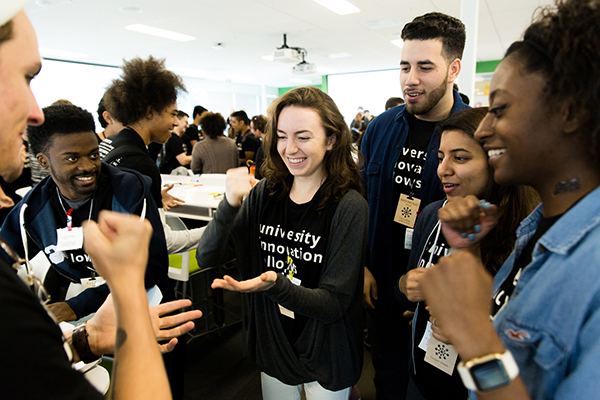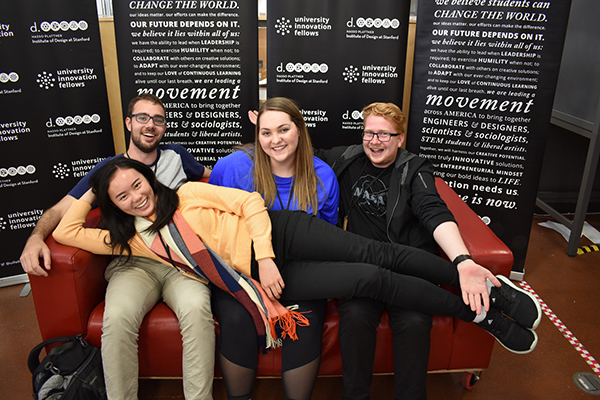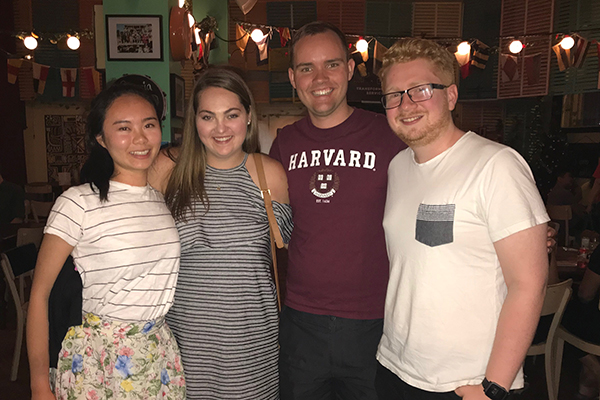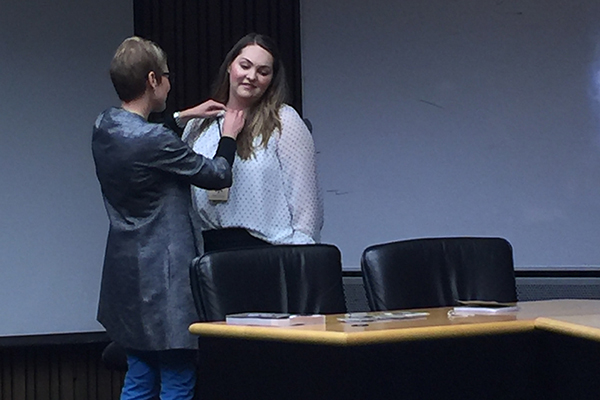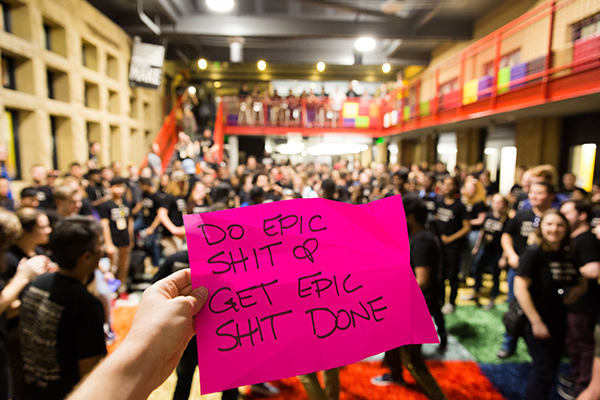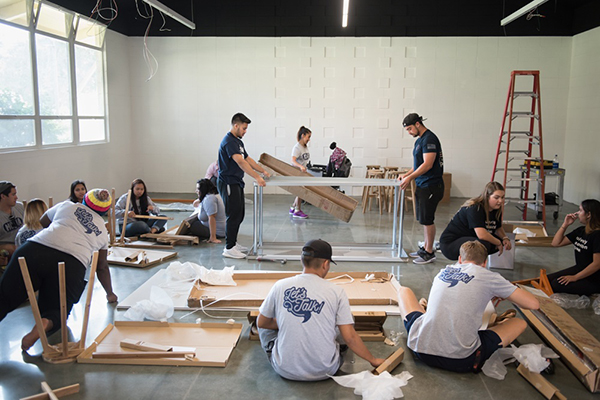How to Turn an Idea into a Reality
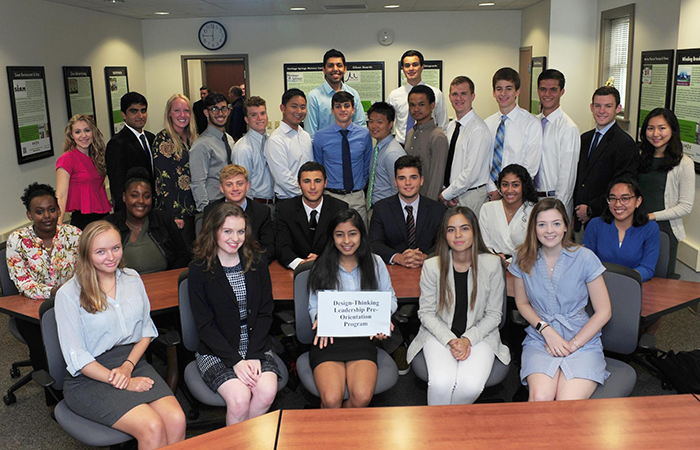
Students after final client presentation of Design Thinking Leadership Pre-Orientation with University Innovation Fellows Kartikeya Sharma (third row, second from left), Jae Lee Young (third row, far right), and William Wall (third row, second from right).
Bucknell Fellow William Wall created a brand new design thinking pre-orientation program in just 10 months.
by William Wall, University Innovation Fellow, Bucknell University
In November 2017, Bucknell’s newest UIF cohort took on the Silicon Valley Meetup. With so many amazing minds and inspirational speeches, I left charged with excitement to make big changes on my campus. Going into the meetup, I had this idea in the back of my mind. I always wanted to design a pre-orientation with a Shark Tank or consultancy aspect. To clarify, a pre-orientation program is an optional 5-day program for incoming first year students in an area of interest prior to the start of college. After basing the unconference at the meetup on this idea, the loads of positive feedback and ideas I received left me filled with passion and excitement.
Immediately after leaving the conference, I began a grand plan and elaborate schemes to pull off this program, and, after 10 months, I finally did. “Design Thinking Leadership” (DTL) is the very first pre-orientation designed and fully run by students at Bucknell University. The program consisted of 7 student leaders educating 21 incoming first year students the process of design thinking as they used it as a framework for consulting proposals for local, small businesses on only their first days of college.
But how exactly did this all take place?
Step 1: The Sell
In order to get an idea rolling, you need buy-in. Luckily, our UIF cohort had scheduled a meeting with the Bucknell Provost Council soon after the UIF meetup. In a quick turnaround, we prepared a formal proposal and our cohort presented DTL as one of our several new planned projects (also included were Student Experience Committee and Entrepreneurship Summit). Since creating a pre-orientation program requires a big name within the administration to sign off, the Provost Council was the perfect opportunity.
A bit shocked, the Provost Council actually agreed for the program planning to continue! Better yet, one of the deans on the council took an interest in the program and started follow-up meetings with our cohort. The crazy part though is that the council wanted the program’s launch date to be fast forwarded from the summer of 2019 to summer 2018. To date, all pre-orientation programs have had a faculty champion dedicated to running the program and planning for the next year begins early in the fall semester. The fact I was just a student planning a program from scratch and not starting until January 2018 became very daunting.
Step 2: Funding
After our team was given the green light and the program was officially launched, I took the reins of the project and commenced with planning. However, nothing in the world, especially on a college campus, gets done without money. With that in mind, the task to find funding was my first challenge. In order to sell the program, both a written proposal and in person presentation were required. Eventually, I was able to secure almost $8,000 for the pilot year from the Dean of Students Office and the Bucknell Innovation Group (BIG). I am currently securing more long term funding for in the future. For those of you interested in large scale project planning, here are the sections the proposal included:
- Program overview
- Tentative program schedule
- Leadership & Advisers
- Program supporters
- Future program pipeline opportunities
- Market analysis
- SWOT framework
- Budget breakdown
- Pilot year vs. Future years
- Marketing plan
Step 3: Marketing
With no proof of success, pictures of past programs, or even anything to compare to Design Thinking Leadership, marketing became a fun challenge. After realizing we could not pitch the program itself, we began marketing the results of it. Instead of talking about design thinking or consultancy, two things the students would have no clue about, we spoke about becoming a campus leader, increasing public speaking abilities, and working on an interdisciplinary team. A lot of great feedback came from using these terms since they resonated more with our target audience. We also had deans and professors of the colleges of liberal arts, management, and engineering recommend this program to incoming students.
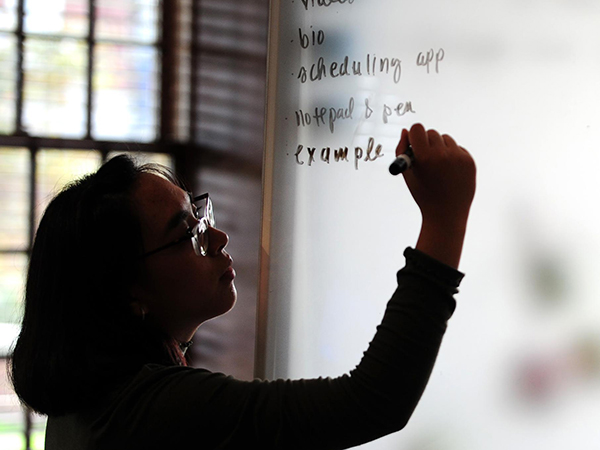
Step 4: Designing
It might be surprising, but the actual designing of the program does not matter if there is not support and means of executing the program first. While there was a schedule, concepts, and ideas prepared for the program prior, the designing of the actual slide decks, activities, and logistics were not fully planned out until last. Additionally, to get excitement and commitment from the student leaders of the program, I had them design several portions of the program to make it feel more like their project than mine.
The student leader team was highly competitive and carefully picked. Each brought a fresh perspective to the program and were very involved students on campus. Along with resume facts, I took particular interest in their personalities. Having leaders that could work on diverse teams and have a flexible work style is essential for a program such as this. With this being a pilot program, we were constantly hit with curve balls and had to readjust our schedule constantly to match the needs of the program. However, my team of student leaders handled their positions perfectly and we had several program participants immediately tell us they want to be leaders for the program in the future!
Step 5: Run the Program!
We launched the pilot program with 21 students participants and 7 student leaders. The participants broke into small groups of 4-5 with one student leader as the “project manager” of the team. The project managers were experts with the company background prior to the program and worked to ignite idea generation of the team members and keep them on track during the short program. The remaining two leaders worked as logistics where one led and facilitated as the other worked behind the scenes with scheduling.
Since DTL is strongly focused on being an interdisciplinary program, we were very happy with the diversity of clients each of our teams had. Teams were split based on personality and working style which we found through the de Bono 6 Hats personality test, observation, and other survey questions. The five clients for the pilot program represented the business fields of professional development coaching, universal landscape design, franchised tutoring services, virtual game design, and cyber security consulting. With the great spread of clients, each participant was able to find a project they were passionate about.
Program Goals
As mentioned, this program included three different stakeholders: Bucknell University, the local business community, and the incoming first year students participating. In order to cater to them all, different features were required in the program. Bucknell University wanted a program desirable for future marketing to showcase the school as innovative and free thinking while also educating incoming first year students. The local business community wanted to be exposed to the Bucknell student population and get feedback and recommendations on their businesses. Lastly, the incoming students wanted something educational, but more so a fun program where they could make lots of friends.
To cater to these stakeholders and more, Design Thinking Leadership has a network of future entrepreneurship and innovative opportunities on campus to pipeline participants; outsourced solely to local, small businesses for all food, activities, and clientele; mixed in tons of fun activities including escape rooms, amusement park, climbing course, outdoor movie, dance party, and tons of ice cream; and so much more!
Program Activities
This section will give you a quick run through of the program details to give you an idea of the high involvement!
Since Design Thinking Leadership is centered around using design thinking as the framework for consulting, the program had to be very fast moving and information heavy, making it essential to mix in tons of fun. Each day was centered around one of the five steps of design thinking to teach the students the steps while they go through that scenario in their consultancy project.
Day 1: Design Thinking Overview
Educational – overview of the concept and steps of design thinking, walkthrough of program details, de Bono 6 Hats of Thinking survey exercises
Fun – introduction games, climbing ropes course, team building exercises, outdoor movie, brownie sundaes and watching TED Talks
Results – The students loved the 6 Hats exercises (resulting color from de Bono test shows how you typically function in a group project). We only wanted to teach only a little bit on the first day and focus more on team building which worked well.
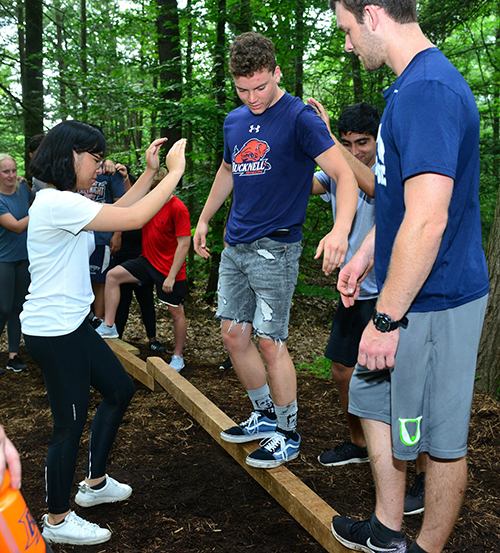
Day 1: Design Thinking Overview
Day 2: Empathize and Define
Educational – landscape canvas, client presentations, client-team meetings, defining a “how might we…” statements, gathering background information
Fun – tour of MakerSpaces, downtown catered dinner, escape rooms, frozen yogurt
Results – Seeing the teams meet and interact with the business owners was the most excited we saw them the entire program. They were ecstatic to work as real consultants asking intelligent questions about the client’s company on only their second day of college.
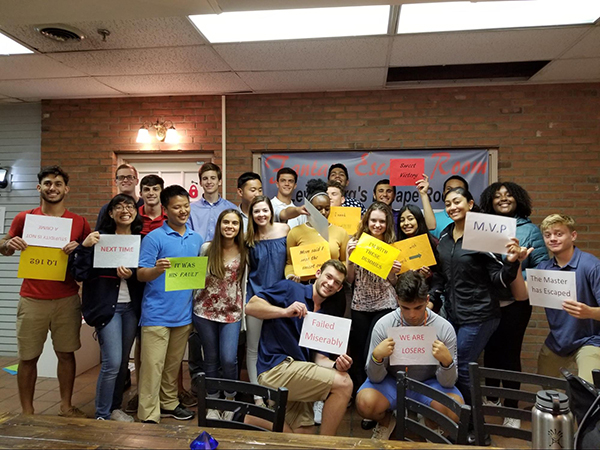
Day 2: Empathize and Define
Day 3: Ideate & Prototype
Educational – sticky note ideation without talking, discussion and categorizing of ideas from ideation, eliminate sticky notes to top 20 ideas, unconference, market analysis and prototype validation
Fun – lunch with dean of students, trivia night, dance party and karaoke
Results – Ideation is my favorite part of design thinking. The session went really well when we had everyone brainstorm and post ideas without talking to each other which eliminated any “black hats” from the process. Categorizing and eliminating to 20 ideas then made them more focused on the client’s absolute needs.
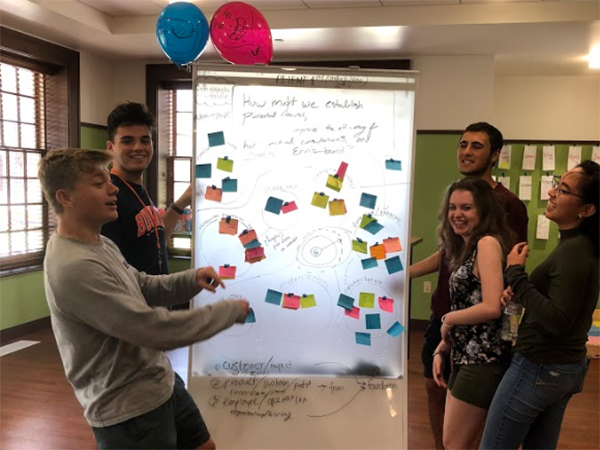
Day 3: Ideate & Prototype
Day 4: Prototype & Test
Educational – continuation of market analysis and prototype validation, finalizing presentation slide decks, run throughs of presentation
Fun – Knoebels amusement park
Results – This day was very work intensive. One of the most important parts of consulting is validation. Each group was required to validate their ideas through either a competitive analysis of best practices, online surveys, or in person interviews. The groups really went all out validating and got ons of feedback which was great.
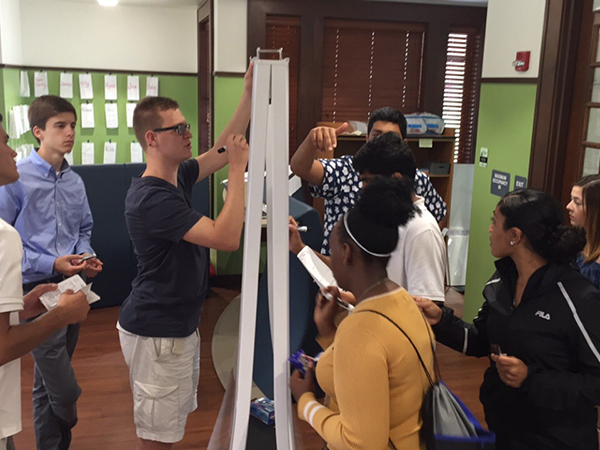
Day 4: Prototype & Test
Day 5: Pitch!
Educational – Presentations
Fun – Presentations
Results – “Extremely impressive/amazing ideas/very professional” all of these were consistent quotes from our business clients and it was phenomenal to hear. The students did an amazing job presenting their projects in a very clean, professional manner. The students gave it their all.
Besides how well spoken and passionate all the students were, my favorite aspect of the program was how interdisciplinary the program was. Design Thinking Leadership had students from engineering to management to politics to life sciences to philosophy and everything in between. Even better, the five local businesses were in the industries of game design, international technology consulting, professional development coaching, universal architectural landscaping, and franchised tutoring services. With the different majors brining different perspectives and the different client industries brining different interests and studies, a large span of ideas were derived from the program!
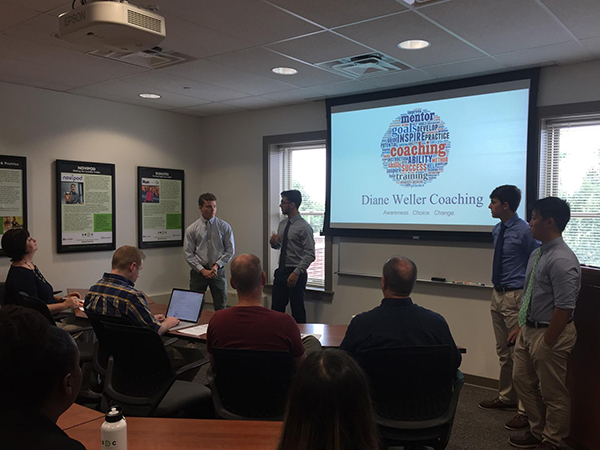
Day 5: Pitch!
Response
If you need motivation to take that step, read this!
The response from the program was honestly unbelievable. I will not go into much detail, but here is how I have been personally affected since holding DTL:
- Contacted by 4 universities reached out asking for my advice and insight to develop the program on their campuses
- Taken out to lunch by an alumnus to discuss my entrepreneurial endeavours
- Presented DTL to the Bucknell Board of Trustees
- Asked by College of Engineering to develop a minor for design thinking
- Featured in 3 articles with two being solely about DTL
- Currently developing business model for franchising program
- Taken out to lunch by dean of engineering to discuss future projects
- Nominated to give speech to 600+ people about student empowerment and big impact
- Invited to NYC to extern at a top 4 consulting firm that uses design thinking
- Asked to write this article! 🙂
Insights
There are only a few things that come to mind that I would like to share with anyone interested in this story.
Take that step: I was terrified to take on this project. It was 10 months of planning with a lot of money at stake and many eyes on me constantly. I am forever grateful that I did and have the confidence to take on any project
Reach out for help: While I was working on this alone for the most part, I definitely reached out for help at several times. I had help from the dean of students, my adviser, and my UIF cohort to lend a hand along the way.
Be confident in your creation: Before the program started, my biggest fear was “What if the students just don’t care?” I came in super excited and energetic regardless, and the students were more passionate and energetic than I could have imagined. I just needed that initial confidence boost to get over my fear.
Stand your ground: With so many stakeholders, there were times where people tried recommending features to the program that I did not believe were beneficial or matched what I had in mind. Despite just being a student, I stood my ground and believed in my program design.
Go for that Moonshot: This was a moonshot idea to say the least. It seemed to be completely out of my reach, but I was passionate and determined and it got done. Never back down from the challenge.
Conclusion
Design Thinking Leadership is an introduction to a new mindset. You learn design thinking, you learn consultancy, you learn to work on a team and interact with a client, but its main goal is just to learn to look at things through a different perspective. Wear different hats, design for your client, empathize for your team member. You can teach a person a thousands of different frameworks and exercises, but the real way to be an innovative thinker is to learn to be compassionate. My goal for this program was to spark passion and drive into the students as they enter Bucknell. With the students soon taking the reins of the campus, I hope to see them accomplish great things and hopefully this program has equipped them with the mindset needed.
If you take anything from this, just remember to always dream big and go for that moonshot idea. You never know where it could lead you.
 About the Author
About the Author
William Wall is a University Innovation Fellow at Bucknell University. While his degree reads mechanical engineering, he is far from just an engineer. Commonly taking classes in both the college of management and arts & sciences, William loves to work interdisciplinary and push the boundaries of his educational experience. He is affiliated with many different entrepreneurial and innovative organizations on campus and is often referred to as a “creator.” His biggest passion is to create something new to enrich his campus and peers. He has an extensive experience building new programs and organizations, independently running $100k+ events, and leading numerous groups on campus. William’s programs are often targeted towards educating underrepresented groups in concepts of engineering, consulting, and entrepreneurship. Covertly coming from a very diverse and challenging background, it is his goal to inspire and empower young students of all backgrounds. To learn more about William Wall, you can view his UIF bio.

